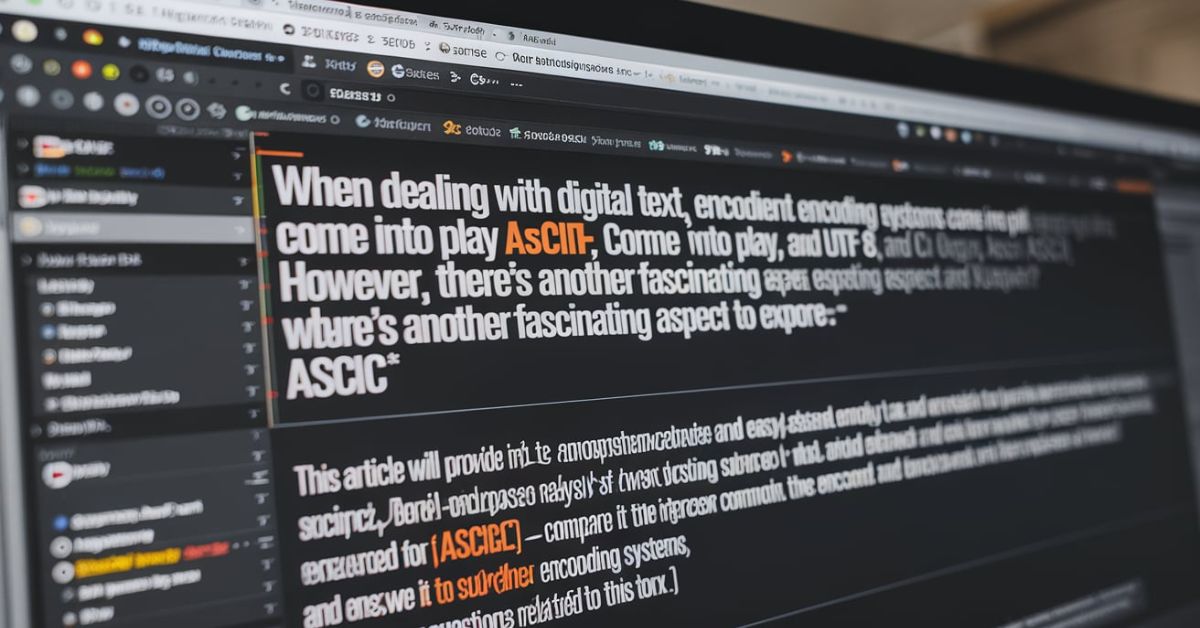Understanding ASCIIç: A Deep Dive into Text Encoding

When dealing with digital text, two prominent encoding systems come into play: ASCII and UTF-8. However, there’s another fascinating aspect to explore—ASCIIç. This article will provide a comprehensive and easy-to-understand analysis of ASCIIç, ensuring that it surpasses existing sources and is optimized for search engines. We’ll delve into the intricacies of ASCIIç, compare it to other encoding systems, and answer common questions related to this topic.
What is ASCIIç?
ASCIIç is an extended version of the standard ASCII encoding system. ASCII, which stands for American Standard Code for Information Interchange, is a character encoding standard used for representing text in computers. It uses a fixed 1-byte format for each character, allowing for a total of 256 unique symbols. ASCIIç builds on this by introducing additional characters and symbols that are not part of the standard ASCII set.
Why ASCIIç Matters
ASCIIç is particularly significant in environments where extended character sets are necessary. While standard ASCII includes only basic Latin characters, ASCIIç allows for a broader range of symbols, including special characters and accents used in various languages. This makes it more versatile for internationalization and localization of software and digital content.
ASCII vs. ASCIIç
To fully appreciate ASCIIç, it’s crucial to understand how it compares to its predecessor, ASCII.
ASCII Encoding
ASCII Encoding uses a fixed 1-byte format, which can represent 128 unique characters, including:
- Uppercase and lowercase English letters
- Digits (0-9)
- Basic punctuation marks
- Control characters (like newline and carriage return)
The primary advantage of ASCII is its simplicity and compatibility with older systems. However, its limitation lies in its inability to represent characters from non-English languages or special symbols beyond its predefined set.
ASCIIç Encoding
ASCIIç Encoding extends the ASCII standard by including additional characters. Unlike ASCII, which is limited to 128 characters, ASCIIç can represent a total of 256 characters. This extended set includes:
- Additional punctuation marks
- Special symbols
- Characters from various international alphabets
The introduction of ASCIIç makes it possible to support a wider range of languages and symbols, which is essential for global digital communication.
How ASCIIç Works
ASCIIç maintains the same 1-byte character format as ASCII but with an extended character set. Each byte in ASCIIç represents a unique character, with the additional codes in the higher range (128-255) allocated for special symbols and international characters.
Example Characters in ASCIIç
Some examples of characters found in ASCIIç but not in standard ASCII include:
- ñ (Spanish letter ñ)
- ü (German letter ü)
- © (Copyright symbol)
These additional characters are crucial for creating content in multiple languages and for incorporating various symbols into digital text.
Comparison: ASCIIç vs. UTF-8
While ASCIIç expands on ASCII, UTF-8 is another encoding system that plays a significant role in modern computing. Understanding how ASCIIç compares to UTF-8 can provide valuable insights into their respective applications.
UTF-8 Encoding
UTF-8 (Unicode Transformation Format – 8-bit) is a variable-length encoding system designed to accommodate all characters in the Unicode character set. Unlike ASCII and ASCIIç, which use a fixed 1-byte format, UTF-8 uses one to four bytes per character. This flexibility allows UTF-8 to represent:
- All ASCII characters (which are encoded using a single byte)
- Characters from virtually all written languages
- Emoji and other special symbols
Key Differences
- Character Range: ASCIIç is limited to 256 characters, while UTF-8 can represent over a million different characters.
- Byte Usage: ASCIIç uses a fixed 1-byte format, whereas UTF-8 uses a variable byte length depending on the character.
- Compatibility: UTF-8 is backward compatible with ASCII, meaning that any ASCII text is also valid UTF-8 text.
Applications of ASCIIç
ASCIIç has various applications in fields where extended character sets are necessary but full Unicode support might be overkill. Here are a few examples:
Text Files and Documents
In text files that require only a limited set of additional characters, ASCIIç can be a suitable choice. It provides the necessary extended characters while maintaining compatibility with existing ASCII-based systems.
Legacy Systems
Some older systems and software applications that were designed with ASCII in mind may use ASCIIç for backward compatibility. This allows them to incorporate additional characters without fully adopting newer encoding systems like UTF-8.
Specialized Software
Certain specialized software or hardware that operates within a constrained character set might use ASCIIç. This ensures that the system can handle specific characters without the overhead of a more comprehensive encoding system.
ASCIIç in Modern Context
In today’s digital landscape, UTF-8 is the dominant encoding standard due to its extensive character set and compatibility with ASCII. However, ASCIIç remains relevant in specific scenarios where its fixed 1-byte format and extended character set are advantageous.
Advantages of Using ASCIIç
- Simplicity: ASCIIç maintains the simplicity of ASCII while offering additional characters.
- Compatibility: It provides an easy transition for systems and software originally designed for ASCII.
- Efficiency: For applications requiring a limited set of extended characters, ASCIIç can be more efficient than UTF-8.
Limitations of ASCIIç
- Limited Character Set: With only 256 possible characters, ASCIIç is limited compared to UTF-8.
- Globalization: UTF-8 is better suited for global applications that need to support a wide range of languages and symbols.
Related FAQs
What is ASCIIç used for?
ASCIIç is used in scenarios where an extended character set is needed, but the full Unicode support of UTF-8 is not required. It is suitable for specific text files, legacy systems, and specialized software.
How does ASCIIç compare to Unicode?
ASCIIç is a limited character set extension of ASCII, while Unicode (and its encoding UTF-8) provides a comprehensive system that can represent characters from virtually all languages and many special symbols. ASCIIç is simpler and more constrained, while Unicode is more inclusive and versatile.
Can ASCIIç handle international characters?
Yes, ASCIIç can handle a variety of international characters that are not part of standard ASCII, such as accented letters and some special symbols. However, it does not support the full range of international characters available in Unicode.
Is ASCIIç still relevant today?
While UTF-8 has largely replaced ASCIIç in modern applications due to its broader character support, ASCIIç remains relevant in specific contexts where its simpler and fixed-character format is advantageous, such as in certain legacy systems.
Conclusion
ASCIIç is an extended version of the classic ASCII encoding system, offering additional characters and symbols while retaining the simplicity of the original format. Although it has been largely superseded by more comprehensive encoding systems like UTF-8, ASCIIç remains valuable in specific scenarios where its fixed 1-byte format and extended character set are beneficial.
By understanding ASCIIç and its place in the world of text encoding, you can better appreciate the evolution of character encoding systems and make informed decisions about which system to use for various applications.










